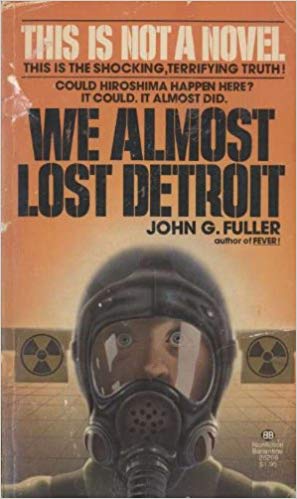A prototype for how NOT to do energy [reviewer’s subtitle]
By John Fuller (1913-1990)
 The motivation to read this book arose from simply the fact that I had heard the book title so many times, I live in the Detroit area, and now work part time where sometimes my route takes me to Monroe, Michigan, where the Fermi plant was built on (in 1966 called) Lagoona Beach of Lake Erie. The book was written in 1975 and reads like a thriller… though as it states on the cover in the form of a subtitle: This Is Not a Novel.
The motivation to read this book arose from simply the fact that I had heard the book title so many times, I live in the Detroit area, and now work part time where sometimes my route takes me to Monroe, Michigan, where the Fermi plant was built on (in 1966 called) Lagoona Beach of Lake Erie. The book was written in 1975 and reads like a thriller… though as it states on the cover in the form of a subtitle: This Is Not a Novel.
I wanted to get the inside skinny on whether or not the title is true. My conclusion is that, yes, on October 5, 1966, in development since 1953, the Enrico Fermi liquid-sodium-cooled fast-breeder nuclear power plant (Fermi 1) experienced a meltdown of some fuel assemblies. At the time of the incident it was unknown how many fuel elements had melted and whether a secondary accident of catastrophic proportions—meltdown of the core, subsequent explosion, violation of containment, and dispersion of radioactive plumes covering 10s of thousands of square miles (including metro Detroit some 50 miles from the site)—was imminent.
You can skip to Chapter 12 thru the epilogue to get the short story of what happened during the early days of October 1966, then subsequently as teams tried to determine what exactly had happened while trying to reach a stable condition where the threat of secondary meltdown was rendered minimal. They were able with extreme, tedious effort to remove the damaged subassemblies by May 1967, then it took another several months to determine the fundamental cause of the overheating: some flow shielding that had come loose and prevented coolant flow to those sections of the core.
About two years later, Autumn 1968, the debris had been cleaned up and estimates for resurrection of an operable reactor were a year and a half down the road. By May 1970 Fermi 1 was nearly ready to resume operation, then in July 1970 the reactor was fired up and, in October 1970, four years after the incident, Fermi reached its designed 200,000 Kilowatt power rating. License renewal loomed in January 1971, the AEC reluctantly did so. But the public was voicing increasing concerns, and Detroit Edison was looking at Fermi increasingly as a major load on its bottom line: Continue reading
